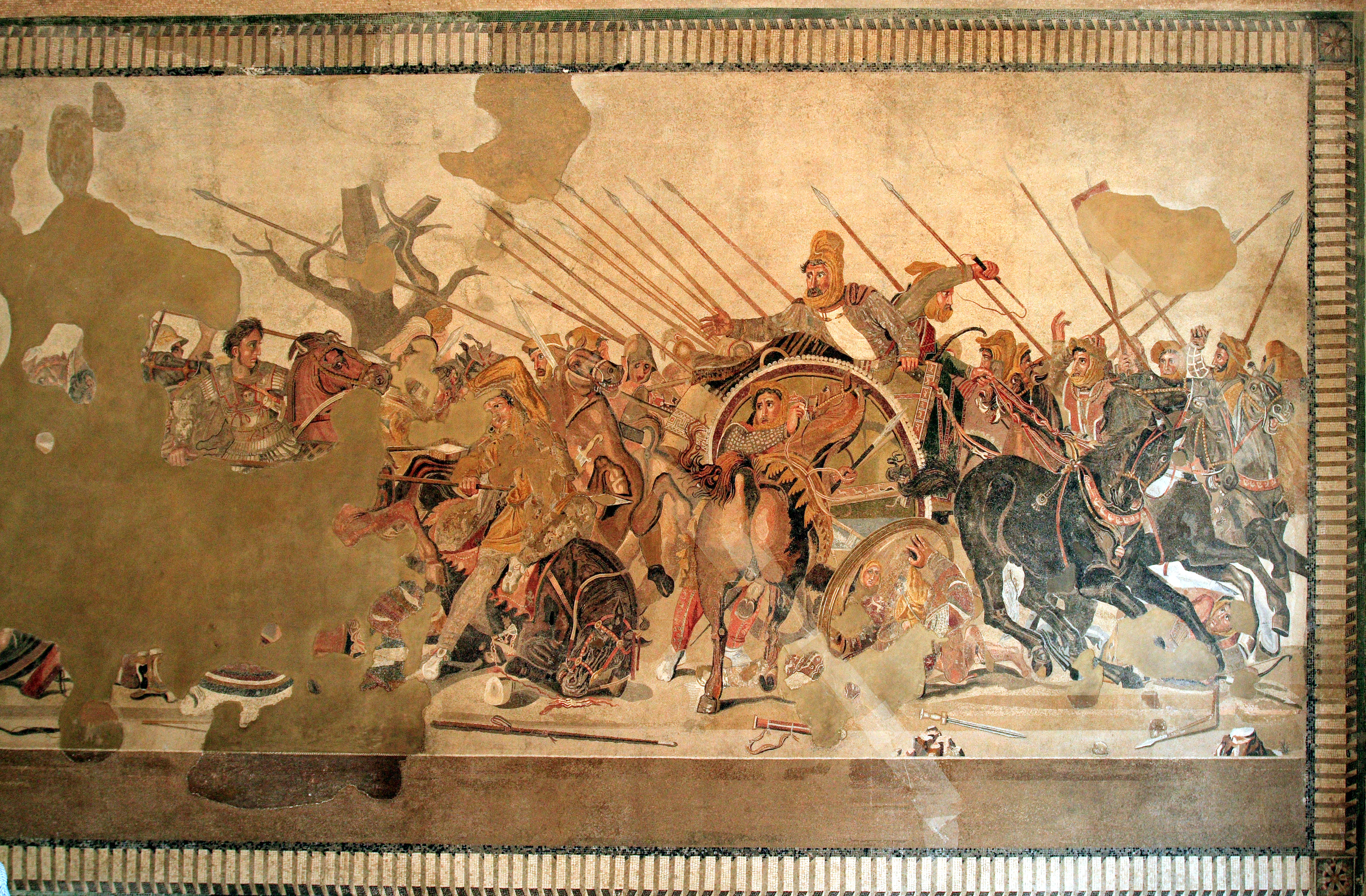- Alexander Mosaic
Infobox Painting|

title=The Alexander Mosaic
artist=Mosaicist unknown
(copy of image byApelles or
Philoxenos of Eretria )
year=c.200 BC
type=mosaic
height=582
width=313
height_inch=19ft
width_inch = 10ft 3 in
diameter_cm =
diameter_inch =
city=
museum=Found atHouse of the Faun ,Pompeii ,
displayed atNaples National Archaeological Museum The Alexander Mosaic or The Battle of Issus, dating from circa 200 BC, is a famousmosaic from theHouse of the Faun ,Pompeii . It depicts a battle between the armies ofAlexander the Great andDarius III of Persia and measures 5.82 x 3.13m (19ft x 10ft 3in).ubject
Which battle?
The mosaic depicts a battle during which Alexander faced and attempted to capture or kill Darius. Both the
Battle of Issus of 333 BC and theBattle of Gaugamela in 331 BC fulfill these criteria, though the first is traditionally held to be likely. Recently, scholars have begun to favor the latter due to the presence of a large, lifeless tree in the center of the mosaic.The mosaic is generally held to be a copy of either a painting by
Apelles contemporary with Alexander himself, or a lost late fourth century BCfresco by the painterPhiloxenos of Eretria . The latter is mentioned byPliny the Elder (XXXV, 110) as a commission for the Macedonian kingCassander .Fact|date=February 2007 The work which we select from these two may influence our opinion on which battle is shown.Alexander and Darius
Despite being partially ruined, the two main figures are easy to recognize.
*The portrait of Alexander is one of his most famous. Alexander's breastplate depicts Medusa, the famousGorgon , and his wavy hair is typical of royal portraiture as established in Greek art of the fourth century B.C. He is portrayed sweeping into battle at the left, on his famous horse,Bucephalos , and focusing his gaze on the Persian leader.
*Darius is shown in a chariot. He seems to be desperately commanding his frightened charioteer to flee the battle, while stretching out his hand either as a mute gesture to Alexander, or possibly after throwing ajavelin . He has a worried expression on his face. The charioteer is whipping the horses as he tries to escape.The Persian soldiers behind him have expressions of determination and
consternation .Other features
Darius's brother Oxyathres is also portrayed, sacrificing himself to save the King.
Radical
foreshortening - as in the central horse, seen from behind - and the use of shading to convey a sense of mass and volume enhance the naturalistic effect of the scene. Repeated diagonal spears, clashing metal, and the crowding of men and horses evoke the din of battle. At the same time, action is arrested by dramatic details such as the fallen horse and the Persian soldier in the foreground who watches his own death throes reflected in a shield.History of the mosaic
Production
The mosaic is made of about one and a half million tiny coloured tiles called
tesserae , arranged in gradual curves called "opus vermiculatum ," (literally, "worm work," because they seem to replicate the slow motion of a crawling worm). The mosaic is an unusually detailed work for a private residence and was probably commissioned by a wealthy person or family. Another theory states that it might have been an originally Hellenic mosaic that was looted from Greece and carried off to Rome. Italian archaeologistFausto Levi supports the first theory.Modern history
The mosaic was rediscovered on
October 24 ,1831 and in the September of 1843 moved toNaples , where it is currently preserved on a wall ("not" floor as it was found) in the Museo Archeologico Nazionale.Modern copy
In 2003 the
International Center for the Study and Teaching of Mosaic (CISIM ) inRavenna , Italy, proposed to create a copy of the mosaic. When they had received approval, the mosaic master Severo Bignami and his eight-person team took a large photograph of the mosaic, made a tracing of the image with a dark marker and created a negative impression of the mosaic.The team composed the mosaic in sections in 44 clay frames, trying to preserve the pieces of the mosaic in the exact positions they are in the original mosaic. They had to keep the plates wet all the time. Then they pressed a tissue on the clay to create an image of the outlines of the mosaic in the clay.
The team recreated the mosaic with about 2 million pieces of various marble types. When they had placed all the pieces, they covered the result with a layer of glue and gauze and pulled it out of the clay. They placed each section on synthetic concrete and then united the sections with the compound of glasswool and plastic.
The project took 22 months and a cost equivalent to US$216,000. The copy was installed on the House of the Faun in 2005.
Photos of the process of making the copy are available at the website of the studio owned by two of the mosaicists that worked on the project, at [http://www.kokomosaico.com/eng/battaglia_di_alessandro/default.html Koko Mosaico]
References
* Marco Merola - " [http://www.archaeology.org/0601/abstracts/mosaic.html Alexander Piece by Piece] " ("Archaeology" magazine January/February 2006)
Wikimedia Foundation. 2010.
